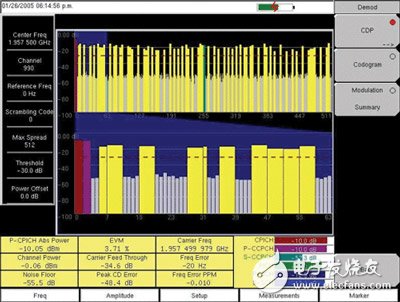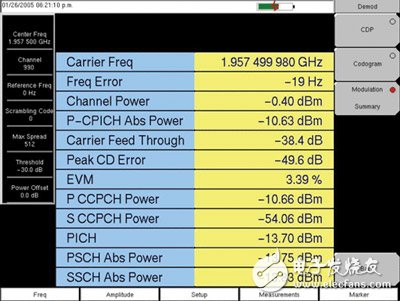The current rapidly evolving third generation wireless communication system greatly improves system performance and quality of service compared to previous second generation wireless networks. In order to achieve higher transmission rates, 3G uses a highly complex modulation system. The rapid development of various 3G base station systems puts forward higher requirements for the stable operation of the WCDMA radio part and the code domain. The maintenance measurement of the UMTS base station system increasingly requires the measurement personnel to perform the frequency domain, the time domain, the amplitude domain, and the modulation domain. Azimuth performance evaluation. This brings new challenges to engineers. The characterization of the WCDMA UMTS Node B transmitter includes two parts, the radio frequency spectrum description and the code domain demodulation description. The measurement based on this description can be performed using a hand-held spectrum analyzer with demodulation function. For example, the new handheld base station tester MT8220A from Anritsu, the WCDMA transmitter portable tester not only includes the traditional signal-based spectrum analysis capabilities, but also carrier frequency, frequency error, occupied bandwidth, channel power, peak average Ratio, noise level, and adjacent channel interference ratio (ACLR??R), and includes modulation domain analysis capabilities that WCDMA transmitters must measure, including spurious characteristics measurements, vector error magnitude (EVM) measurements, carrier feedthrough measurements, Primary/Secondary Common Control Physical Channel (P-CCPCH/S-CCPCH), Primary/Secondary Synchronization Channel (P-SCH/S-SCH), Paging Indicator Channel (PICH), Common Pilot Channel (CPICH), Dominant Frequency Modulation domain indicator such as channel absolute power level. By utilizing advanced semiconductor technology, Anritsu has successfully developed a series of small RF/microwave devices. This allows the index and performance of a comparable tabletop instrument to be achieved at a compact weight of 2.9kg. Based on the new high-performance 7.1GHz spectrum analyzer platform, coupled with powerful WCDMA demodulation function, it can truly measure and analyze at any time and any place. The average noise floor level as low as -153dBm is also far ahead in handheld meters. It also strengthens the performance and indicators of the Spectral Emission Mask and ACLR (Figure 1). Figure 1: Code Domain Demodulation Measurement The MT8220A's built-in spectrum analysis mode is optimized for WCDMA base station RF measurements. The RF measurements include carrier frequency, frequency error, occupied bandwidth, channel power, peak-to-average ratio, noise level, and ACLR. ACLR Measurements—Normally due to the nonlinearity of the linear power amplifier, the system produces a higher ACLR, and adjacent channel power leakage contributes to the channel noise floor. It directly reduces the amount of system redundancy/capacity, and the ACLR feature will greatly affect the working status and communication status of other sites. Excessive values ​​will give mobile phone users a so-called near-far effect. Handheld spectrum analyzers typically have built-in signal filters that strictly define the bandwidth and shape factor of the ACLR measurements to meet the 3dB bandwidth strictly equal to the chip rate. Through the built-in ACLR measurement mode of the MT8220A, users can accurately obtain accurate leakage values ​​from the carrier 5MHz and 10MHz. Signal spurious measurement---MT8220A also provides WCDMA spurious test mode, built-in standard 3GPP spurious template. As the signal size changes, the template measurement will indicate whether the spurious indicator is PASS or FAIL. The concise result is easy for user identification. . Code Domain Demodulation Measurement---The code domain demodulation test mode provided by MT8220A provides test for WCDMA signal quality. This test mode can be used for P-CCPCH, S-CCPCH, P-SCH, S-SCH, PICH, CPICH, Absolute power measurement of P-CPICH channel and measurement of parameters such as code channel power, EVM, and carrier feedthrough. In this mode, the MT8220A demodulates the received signal and provides three display modes: code domain power display, code spectrum display, and modulation list display. The code domain power shows all selected OVSF codes, and the appropriate power levels on the P-CPICH, P-SCH, and S-SCH channels are critical to optimizing network capacity and quality. These power measurements can only be made by test equipment that can correctly demodulate the transmitted signal and analyze the power level in the code domain. These signals determine the coverage of the cell and must be set within appropriate limits. Code Spectrum Test—Displays the code domain power on a color scale, and builds a display of different time from bottom to top on the vertical axis, including each subsequent trace of the power and code channels. The code spectrum shows the characteristics of base stations with different data rates and service requirements. By evaluating the code spectrum, important diagnostic information related to the W-CDMA system can be obtained. This provides an efficient way to verify and analyze the characteristics of the traffic channel and signaling channel in the base station. Signals with high data rates are usually transmitted quickly and are otherwise difficult to observe. Code spectrum analysis can also track traffic load at different times, showing call volume and call power. Figure 2: Modulation project list display Over-the-air measurement mode---The three modes can be performed by antenna or directly connected to NodeB. All three modes can directly display carrier frequency power, frequency and channel power, but not all base stations can support all three modes. mode. For example, measurements that are directly connected to the NodeB can only measure the occupied bandwidth, ACLR, spurious characteristics, and peak-to-average ratio. Through the air interface, the MT8220A can help users automatically capture the strongest 6 groups of scrambling codes. Users can also specify the scrambling code number manually. The scrambling code analysis detects the pilot power level of each received WCDMA downlink signal, shown here as (Ec). The scrambling code analysis also detects ambient noise and calculates Ec/Io using ambient noise (Io). This is equivalent to the signal-to-noise ratio of each sector in WCDMA, so that the coverage quality of the location can be easily determined. The measurement information provided by the MT8220A in the over-the-air measurement mode includes total power, pilot power (CPICH), Ec/Io, Ec, and pilot tolerance parameters.
White IDC Connector :IDC connector Automotive Connector is a kind of component that electronic engineering and technical personnel often contact. Its function is very simple: in the circuit is blocked or isolated between the circuit, set up a bridge of communication, so that the current flow, so that the circuit to achieve the intended function. The form and structure of automobile connector are changeable. It is mainly composed of four basic structural components: contact, shell (depending on the variety) and insulator. White IDC Connector ShenZhen Antenk Electronics Co,Ltd , https://www.antenksocket.com
